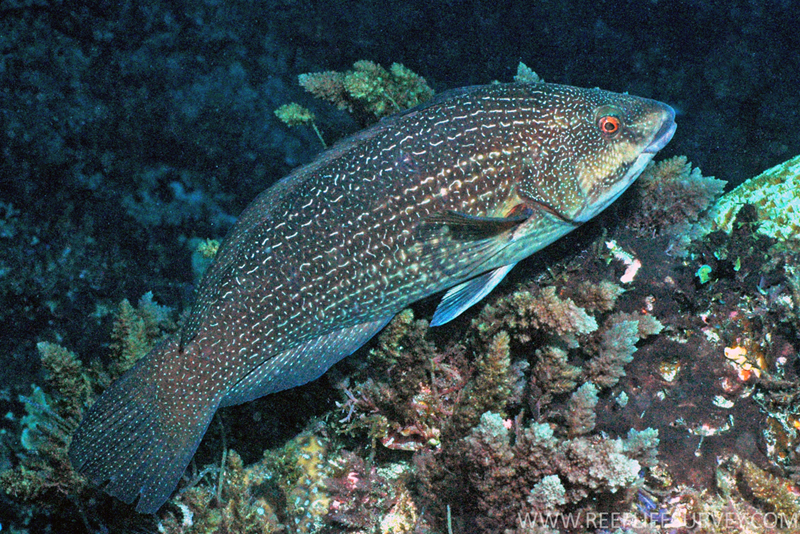- Classification
- ACTINOPTERYGII
- PERCIFORMES
- LABRIDAE
- Notolabrus
- inscriptus
Inscribed Wrasse, Notolabrus inscriptus (Richardson 1848)

An Inscribed Wrasse, Notolabrus inscriptus, off Malabar Hill, Lord Howe Island in the Tasman Sea. Source: Graham Edgar / Reef Life Survey. License: CC BY Attribution
A large wrasse that usually occurs around offshore islands and is rare in coastal waters of mainland Australia.
Small juveniles are greenish with white markings and an ocellus on the soft dorsal and anal fins. Females are brownish with white markings on the scales that form fine horizontal stripes. Males are bluish-grey with a 'scribbled' pattern on the scales and white dorsal and anal fins.
Inscribed Wrasse, Notolabrus inscriptus (Richardson 1848)
More Info
|
Distribution |
Known from temperate waters of southeastern Australia, from about Sydney to Eden, NSW, and Lord Howe and Norfolk islands; depth range 1-30 m. Found elsewhere in New Zealand, including the Kermadec Islands. The Inscribed Wrasse usually occurs on exposed reefs around offshore islands. Although rare on the Australian mainland, the species is abundant at Lord Howe and Norfolk islands. |
|
Feeding |
Carnivore - feeds on benthic invertebrates - mostly molluscs and crustaceans. |
|
Biology |
The Inscribed Wrasse is a protogynous hermaphrodite. The smaller adults are female, and some change sex to become males during their life. Males defend a large territory, and usually share it with up to six juveniles and females. |
|
Conservation |
|
|
Remarks |
The Inscribed Wrasse has been known to hybridise with the Purple Wrasse, Notolabrus fucicola in northern New Zealand (Ayling 1980). |
|
Etymology |
The specific name inscriptus is from the Latin word for 'inscribed' or 'written', in reference to the scribble-like markings on the body. |
|
Author |
Dianne J. Bray |
Inscribed Wrasse, Notolabrus inscriptus (Richardson 1848)
References
Coleman, N. 1980. Australian Sea Fishes South of 30ºS. Lane Cove, NSW : Doubleday Australia Pty Ltd 309 pp.
Eddy, T.D. 2011. Recent observations of reef fishes at the Kermadec Islands marine reserve, New Zealand. N. Z. J. Mar. Freshwat. Res. 45(1): 153-159.
Francis, M. 1993. Checklist of the coastal fishes of Lord Howe, Norfolk, and Kermadec Islands, southwest Pacific Ocean. Pacific Science 47(2): 136-170 figs 1-2
Hutchins, J.B. & Swainston, R. 1986. Sea Fishes of Southern Australia. Complete field guide for anglers and divers. Perth : Swainston Publishing 180 pp.
Kuiter, R.H. 1993. Coastal Fishes of South-eastern Australia. Bathurst : Crawford House Press 437 pp.
Eddy, T.D. 2011. Recent observations of reef fishes at the Kermadec Islands marine reserve, New Zealand. N. Z. J. Mar. Freshwat. Res. 45(1): 153-159.
Richardson, J. 1848. Ichthyology. 75-139 pls 42-43 & 44 (parts), 45-52, 53 in Richardson, J. & Gray, J.E. (eds). The Zoology of the Voyage of H.M.S. Erebus and Terror under the Command of Captain Sir James Clark Ross, R.N., F.R.S., during the years 1839–43. London : Smith, Elder & Co. Vol. 2 139 pp.
Russell, B.C. 1983. The food and feeding habits of rocky reef fish of north-eastern New Zealand. New Zealand Journal of Marine and Freshwater Resources 17(2): 121-145.
Russell, B.C. 1988. Revision of the labrid fish genus Pseudolabrus and allied genera. Records of the Australian Museum, Supplement 9: 1-72. PDF Open access
Russell, B. 2010. Notolabrus inscriptus. In: IUCN 2012. IUCN Red List of Threatened Species. Version 2012.2. <www.iucnredlist.org>. Downloaded on 05 November 2012.
Waite, E.R. 1909. A list of the known fishes of Kermadec and Norfolk Islands, and a comparison with those of Lord Howe Island. Trans. N.Z. Inst. 42:370-383.








